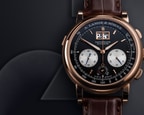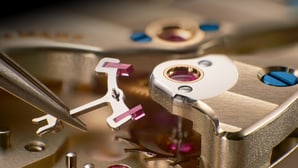In 1831, Joseph Thaddaeus Winnerl presented his chronoscope in Paris: It was the first pocket watch with a seconds hand that could be stopped and restarted without having to stop the entire movement. It was the first watch that allowed the duration of an event to be measured without losing the current time. Unlike today’s solutions, the respective mechanism was located beneath the dial. One of Winnerl’s most eager students was Ferdinand A. Lange, who spent a large portion of his apprenticeship years under Winnerl’s supervision.
The first split-seconds mechanism
In the years leading up to 1838, Winnerl then developed the first split-seconds mechanism. It had two superposed seconds hands that could be separately stopped and resynchronised. One of them indicated the beginning, the other one the end of an event. The time difference allowed the stopped time to be calculated. With a bit of creativity, two times could be determined as well. The practicality was still somewhat limited because it was not possible to zero both hands.
The invention of the zero-reset heart cam
In 1844, Adolphe Nicole was granted a patent for a mechanism that made it possible to zero the seconds hand. The “heart” of this mechanism is a so-called zero-reset heart cam, which is still used in most mechanical chronographs today. But it took another 18 years before he presented this device in a watch case. In 1862, it was the first pocket watch that mastered all three basic functions that constitute a chronograph: start, stop and reset. This invention also lent itself to rattrapante hands.
Switched sides and minute counter
Around 1880, Auguste Baud placed the entire chronograph and split-seconds mechanism on the caseback side for the first time, making it much easier to adjust. Consequently, the characteristic rattrapante clamp was now visibly integrated in the movement. Baud also enriched the chronograph by adding a minute counter that allowed the measurement of longer time intervals.
Split-seconds hands for the wrist
The first wrist chronographs with rattrapante hands emerged around 1912. The movements were still as large as pocket watches, but they were gradually miniaturised and in the 1930s had the same format as ordinary wristwatches. Accommodating the plethora of levers, springs and clamps in such a small space was a noteworthy horological accomplishment.
Pinnacle, demise, and revival
The first serially produced basic movements with a split-seconds function were introduced in the 1940s. But two decades later, they almost totally disappeared from the market. For a long time, split-seconds chronographs all but vanished. When mechanical watches reappeared in the 1980s and 1990s, they attracted attention again and some watch brands introduced new models, often with improved or innovative mechanisms. But in all of them, the rattrapante function was restricted to the seconds-counter range.
The first double rattrapante
In 2004, for the first time in the history of precision watchmaking, A. Lange & Söhne presented a double rattrapante chronograph: the DOUBLE SPLIT. The watch had not only two seconds counters but also two minute counters. Its rattrapante seconds counters and rattrapante minute counters could be stopped independently of the chronograph hands and later resynchronised again. This extended the range for lap-time measurements from 60 seconds to 30 minutes. So far, no other watchmaking company offers this function.
The apex of the rattrapante function
While even the DOUBLE SPLIT has no competition, the TRIPLE SPLIT that debuted in 2018 goes a step further. It embodies the pinnacle in the evolution of the rattrapante function and is deemed the ultimate chronograph. With the addition of a third, separately stoppable hand pair, the chronograph and rattrapante functions can now be used for measurements that last up to 12 hours. This is achieved with a manufacture movement of incomparable complexity.
Explore further




Exclusive insights into the world of fine watchmaking
Experience A. Lange & Söhne’s fascinating heritage, unique stories and exquisite timepieces by subscribing to our newsletter.
How can we be of service?
Whether you are in search of a specific model, have questions out of interest or need a service request for your timepiece – we are delighted to help you. We are at your service by phone, email or in one of our boutiques.









